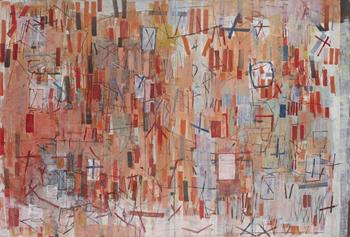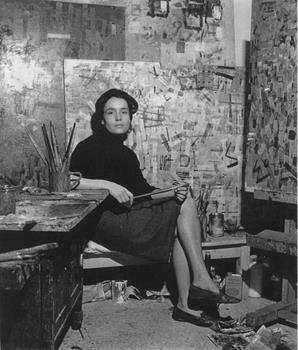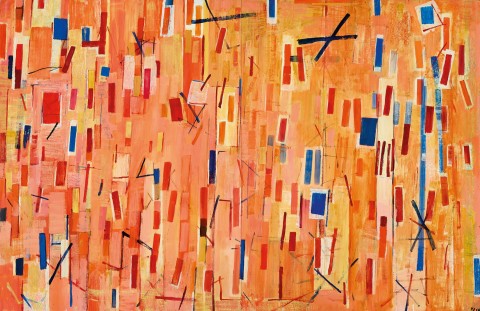CANTATA NO. 14, 1963 – 64
YVONNE AUDETTE
oil on composition board (diptych)
120.0 x 184.0 cm overall
signed and dated lower right: YA 64
signed, dated and inscribed with title verso: Cantata No 14/ Y Audette/ 1963/64
Private collection, Melbourne
Cantata no. 12, oil on composition board, 130.2 x 192.2 cm, in the collection of the National Gallery of Victoria, Melbourne
dh200290_YVONNE AUDETTE, Cantata no. 12, The journey 1963.jpg

Yvonne Audette holds a unique position in twentieth century Australian art as one of the few female artists of her generation to have maintained a long and successful career working in an abstract mode. She left Australia to further her studies in late 1952, however unlike most of her peers, headed to New York, influenced by her American-born parents’ agreement to provide financial support if she went there rather than to Europe. While her training had been traditionally academic, with an emphasis on the figure, Audette’s first-hand exposure to the work of artists including Willem de Kooning (whose studio she visited in 1953), Robert Motherwell and Mark Tobey brought her face to face with the burgeoning New York School of Abstract Expressionist painting and she began to move confidently towards abstraction, developing a unique visual language that merged a lyrical use of colour with dextrous mark-making and the textural layering of line and abstract form.
After travelling in Europe Audette settled in Florence, establishing a studio there in 1955.1 Against the backdrop of Italy’s rich culture and artistic past, she was welcomed into a community of professional artists (including Arnaldo Pomodoro and Lucio Fontana) who encouraged her and provided an aspirational example. Focussed and determined, Audette worked hard, holding commercial exhibitions in Florence, Milan, Paris, Rome and London.
While Audette’s work was rarely seen in Australia during her expatriate years, it has since been recognised for her important contribution to the history of twentieth century art in this country. Acquisitions by major public galleries were followed by a series of institutional exhibitions – Queensland Art Gallery (1999), Heide Museum of Modern Art (2000), National Gallery of Victoria (2008), Ian Potter Museum of Art (2009) and the Art Gallery of Ballarat (2016) – and the publication of a major monograph in 2003.
Audette was awarded Member of the Order of Australia (AM) in the June 2020 Queen's Birthday Honours List for significant service to the visual arts as an abstract painter.
1. Audette lived in Florence until 1963, relocating to Milan before returning to Australia permanently in 1966.
KIRSTY GRANT
dh200290_YVONNE AUDETTE IN FLORENCE.jpg

‘I am interested in the musicality of the abstract mark. I tried to achieve in paint what I experienced in music, particularly the Bach Cantatas. Bach’s Cantatas breathed for me a kind of mystical joy.’1
Yvonne Audette’s striking painting Cantata No. 14 of 1963-64 was created by the then thirty-three-year old artist in her studio in Milan during her lengthy period in Europe. Significantly, this major painting has never before been exhibited or illustrated during the fifty-six years since that time.
The best things in life are abstract. Abstract nouns strive to codify an intangible world of ideas, emotions or mental states to outline those core attributes that are the most human of all – beauty, love, hope, emotion and a host of other conceptualised refinements. Audette’s paintings aim to capture and convey such refinements. She addresses and gives pictorial shape to such states of mind – she ‘keeps revealing the inwardness of our being’ in Professor Chris Wallace-Crabbe’s pinpointed phrase.2 It was this artistic internality that occasioned her noteworthy mention in the New York Guggenheim Museum’s major exhibition The Third Mind: American Artists Contemplate Asia, 1860-1989 of 2009, as curated by its Senior Curator, Dr. Alexandra Munroe.3
In other words, Audette’s paintings are prompted by a ’call and response’ interaction with the world of felt sensation. Her unique artistic ’voice’ and its interactive mode have long been recognised by discerning collectors and curators – from the very first of her thirty-nine solo exhibitions (Gallery Schettini, Milan, 1958) through to her equal number of group exhibitions. Certainly, in Audette, the results of such a mode produce refined paintings with optically seductive richness and compositional finesse, but the sustained power of its prime effect upon the viewer lies in the ways that her paintings induce what might be called an empathetic mentation – that is, the eye wanders over layered surfaces, takes in subtle colours and modulated lines; the mind loosens and is led inwards toward an opened-out and aestheticised self-talk. Clearly, Audette’s paintings are about something rather than of something.
The ‘aboutness’ of Audette’s Cantata No. 14 resides in her heartfelt love of J. S. Bach’s music, which she studied as a young student of classical piano and violin at Sydney’s Conservatorium of Music. Bach’s aural flows and contrapuntal harmonies remain supreme marvels and it’s best to think of Audette’s painting as an artistic ‘reverberation’ of his music – it certainly is not a ’visualisation’ or an ’interpretation’. The matter runs deeper and might usefully be considered as her visual emulation of Bach’s artistic example – that is, as a personal correlative that creates and sets down painterly elements in abstract compositions in ways that might best draw out inner sensation.
The artist, in her private notes, puts it more movingly:
‘I tried in my paintings to isolate the vibrations of tone and colour to musical sound. … the textural beauty created by combinations of stringed instruments playing the choral melody, and the utterly different vocal parts, send images and messages to me of contrasting colours and a dynamic spatial structure. I tried to create those combinations of two or more independent melodies in line and colour and to create harmonic textures equivalent to counterpoint. … it became an underlying structure that I chose to develop.’4
Given all of the above, Yvonne Audette’s Cantata No. 14 stands as a hallmark painting that represents the artist at a pivotal phase in her notable life.
1. Personal notes in the possession of the artist
2. Heathcote, C., Adams, B., Vaughan, G. and Grant, K., Yvonne Audette Paintings and Drawings 1949-2014, Macmillan Art Publishing, Melbourne, 2014, p.20
3. The Third Mind: American Artists Contemplate Asia, 1860-1989, Guggenheim Museum, New York, 2009, pp. 153-154. Audette’s painting The Grey Wall with Lines, 1957 in the Queensland Art Gallery, Brisbane was requested to be shown in the New York exhibition. Two factors prevented this: the costs associated with international transportation and the lapsing of Audette’s previous American citizenship.
4. Personal notes in the possession of the artist.
KEN WACH
